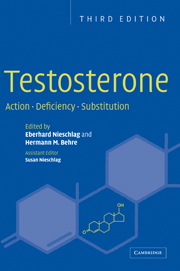Book contents
- Frontmatter
- Contents
- List of contributors
- Preface
- 1 Testosterone: an overview of biosynthesis, transport, metabolism and non-genomic actions
- 2 The androgen receptor: molecular biology
- 3 Androgen receptor: pathophysiology
- 4 Behavioural correlates of testosterone
- 5 The role of testosterone in spermatogenesis
- 6 Androgens and hair: a biological paradox
- 7 Androgens and bone metabolism
- 8 Testosterone effects on the skeletal muscle
- 9 Androgens and erythropoiesis
- 10 Testosterone and cardiovascular diseases
- 11 Testosterone and erection
- 12 Testosterone and the prostate
- 13 Clinical uses of testosterone in hypogonadism and other conditions
- 14 Pharmacology of testosterone preparations
- 15 Androgen therapy in non-gonadal disease
- 16 Androgens in male senescence
- 17 The pathobiology of androgens in women
- 18 Clinical use of 5α-reductase inhibitors
- 19 Dehydroepiandrosterone (DHEA) and androstenedione
- 20 Selective androgen receptor modulators (SARMs)
- 21 Methodology for measuring testosterone, DHT and SHBG in a clinical setting
- 22 Synthesis and pharmacological profiling of new orally active steroidal androgens
- 23 Hormonal male contraception: the essential role of testosterone
- 24 Abuse of androgens and detection of illegal use
- Subject Index
1 - Testosterone: an overview of biosynthesis, transport, metabolism and non-genomic actions
Published online by Cambridge University Press: 18 January 2010
- Frontmatter
- Contents
- List of contributors
- Preface
- 1 Testosterone: an overview of biosynthesis, transport, metabolism and non-genomic actions
- 2 The androgen receptor: molecular biology
- 3 Androgen receptor: pathophysiology
- 4 Behavioural correlates of testosterone
- 5 The role of testosterone in spermatogenesis
- 6 Androgens and hair: a biological paradox
- 7 Androgens and bone metabolism
- 8 Testosterone effects on the skeletal muscle
- 9 Androgens and erythropoiesis
- 10 Testosterone and cardiovascular diseases
- 11 Testosterone and erection
- 12 Testosterone and the prostate
- 13 Clinical uses of testosterone in hypogonadism and other conditions
- 14 Pharmacology of testosterone preparations
- 15 Androgen therapy in non-gonadal disease
- 16 Androgens in male senescence
- 17 The pathobiology of androgens in women
- 18 Clinical use of 5α-reductase inhibitors
- 19 Dehydroepiandrosterone (DHEA) and androstenedione
- 20 Selective androgen receptor modulators (SARMs)
- 21 Methodology for measuring testosterone, DHT and SHBG in a clinical setting
- 22 Synthesis and pharmacological profiling of new orally active steroidal androgens
- 23 Hormonal male contraception: the essential role of testosterone
- 24 Abuse of androgens and detection of illegal use
- Subject Index
Summary
Introduction
Androgens in the male are essential for the development and maintenance of specific reproductive tissues such as testis, prostate, epididymis, seminal vesicles and penis, as well as other characteristic male properties such as increased muscle strength, hair growth, etc. (Mooradian et al. 1987). In order to maintain the androgen concentration at appropriate levels, the production rates of androgens must be in balance with the metabolic clearance and excretion. The action of androgens in target cells depends on the amount of steroid which can penetrate into the cells, the extent of metabolic conversions within the cells, the interactions with the receptor proteins and finally, upon the action of the androgen receptors at the genomic level.
The biochemical aspects of production, metabolism, transport and action of androgens will be discussed in separate sections. Where possible, data obtained from human tissues will be emphasized. This chapter will deal with only the major and general aspects. A more extensive description of these topics and can be found in the book “The Leydig Cell” edited by Payne et al. (1996).
Biosynthetic pathways
General
In the human male, testosterone is the major circulating androgen. More than 95% is secreted by the testis, which produces approximately 6–7 mg per day (Coffey 1988). The metabolic steps required for the conversion of cholesterol into androgens take place in approximately 500 million Leydig cells that constitute only a few percent of the total testicular volume.
- Type
- Chapter
- Information
- TestosteroneAction, Deficiency, Substitution, pp. 1 - 38Publisher: Cambridge University PressPrint publication year: 2004
- 10
- Cited by

